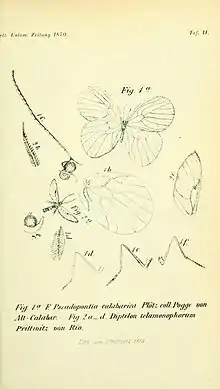Pseudopontia paradoxa
Pseudopontia paradoxa is a species of butterfly found only in wet forests of tropical Africa. It was traditionally thought to be the only species (monotypic) in the genus Pseudopontia and the subfamily Pseudopontiinae. However, a recent study showed there are at least five species of Pseudopontia which can be distinguished genetically and by details of wing veins. Each is found primarily in a different part of Africa, though several of the species have overlapping geographic distributions.
| Pseudopontia paradoxa | |
|---|---|
 | |
| Scientific classification | |
| Domain: | Eukaryota |
| Kingdom: | Animalia |
| Phylum: | Arthropoda |
| Class: | Insecta |
| Order: | Lepidoptera |
| Family: | Pieridae |
| Genus: | Pseudopontia |
| Species: | P. paradoxa |
| Binomial name | |
| Pseudopontia paradoxa (Felder, 1869) | |
| Synonyms | |
| |
It is considered paradoxical because, despite being a true butterfly (Papilionoidea), its antennae do not have the characteristic clubbed ends which are otherwise diagnostic of butterflies (Rhopalocera).
The larvae feed on Pseuderanthemum tunicatum, Rhopalopilia marquesii and Rhopalopilia pallens.[1]
References
Sources
- Plötz, C. (1870) Pseudopontia Calabarica n. gen. et n. sp. Stettiner Entomologischer Zeitung, 31, 348–349, 1 pl.
- Felder, R. (1869) [no title]. Petites Nouvelles Entomologiques, 1, 30–31.
- Felder, R. (1870) Gonophlebia (Globiceps), Paradoxa (Felder). Petites Nouvelles Entomologiques, 1, 95.
- Dixey, F.A. (1923) Pseudopontia paradoxa: its affinities, mimetic relations, and geographical races. Proceedings of the Entomological Society (London), lxi–lxvii +plate B.
- Mitter, K.T., Larsen, T.B., et al. (2011). The butterfly subfamily Pseudopontiinae is not monobasic: marked genetic diversity and morphology reveal three new species of Pseudopontia (Lepidoptera: Pieridae). Systematic Entomology 36: 139–163. DOI: 10.1111/j.1365-3113.2010.00549.x